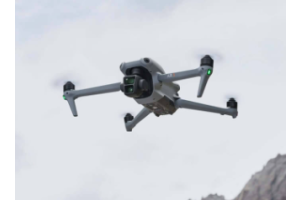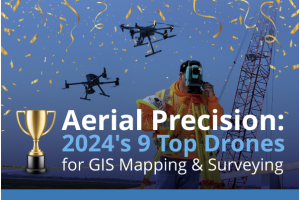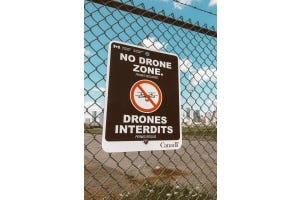When Every Second Counts
In the evolving world of drone technology, the Teledyne FLIR SIRAS has come out a professional and cost-effective solution for search and rescue missions. Emergency responders are drawn to it for its fusion of thermal imaging and high-resolution photography, optimizing the drone's efficacy in critical life-saving scenarios. But before we look at this and more that the drone brings on board, what kind of problems do SAR teams face when responding to these emergencies?
Challenges Faced In Search And Rescue Operations
· Time Constraints: Time is of the essence in SAR missions. The first few hours are often referred to as the "golden hours," a period where the chances of a successful rescue are highest. Take avalanche scenarios for instance. If someone is fully buried and is rescued in the first 15-20 minutes, they have a 90% chance of surviving. But after about 35 minutes, that chance drops to 30%.
In the aftermath of an earthquake, on the other hand, victims trapped under rubble have a significantly higher chance of survival if they are found and treated within 72 hours. After this, the survival rate drops dramatically, and it’s the case for most natural disasters. Any delay can potentially lead to a loss of life.
· Unpredictable Weather Conditions: Weather, always a wild card, can prove to be a significant hurdle in SAR operations. In mountainous regions, for example, clear skies can swiftly give way to dense fog or heavy snowfall, severely limiting visibility and complicating search efforts.


Such sudden weather changes not only hinder the mission but also put the rescuers at risk, making the unpredictable nature of weather a formidable challenge.
For instance, in January 2023, challenging weather conditions in the San Gabriel Mountains obstructed search efforts for two missing hikers, including British actor Julian Sands.
The San Bernardino County Sheriff's Department highlighted that the prevailing weather and low cloud coverage significantly impacted the deployment and choice of resources for the search. Due to these conditions, there has been an increase in rescue missions in the area, with two fatal falls reported in the month prior.
· Vast or Inaccessible Terrains: The topography of the search area often poses substantial challenges. Whether it's the vast expanse of a dense forest where a lost
individual could be anywhere or the rugged cliffs that are nearly impossible to navigate by foot, the terrain can be a daunting adversary.
Some areas are so remote or treacherous that they're almost entirely inaccessible, necessitating aerial searches or specialized equipment.
The Amazon Rainforest in particular, spanning over 6.7 million km², has numerous cases of individuals getting lost each year due to its vast and dense landscape. After a plane crash in the Amazon, 4 Indigenous children endured 40 days in the treacherous jungle before being rescued.
Despite the relentless efforts of search teams, the thick jungle canopy, mist, and dense foliage made locating the children incredibly challenging, even causing rescuers to miss the children by mere meters on several occasions. The eventual discovery of the children was attributed to a combined approach, using both modern military tactics and traditional Indigenous techniques. The rescue combined the efforts of 150 soldiers, volunteers from Indigenous tribes, and both modern and ancestral search techniques, highlighting the vastness and difficulty of searching in the expansive Amazon area.
· Imperative Need for Accurate Data: Precision is paramount in SAR operations. The information that teams work with has to be accurate. Say it’s a case of a hiker out on the trial with a malfunctioning personal locator beam, or searching for a lost vessel in the vastness of the ocean – if the last known GPS coordinates are even slightly off, the search teams could waste hours or even days searching the wrong area. A 1% error in GPS accuracy in a 100 sq.km area can increase the search region by an additional sq.km, making search and rescue operations significantly more time-consuming and resource-intensive. The tragic and unsolved mystery of Malaysia Airlines Flight MH370 from 2014 underscores the dire need for accurate data in SAR operations. Accurate real-time updates and reliable data are the backbones of successful search missions.
· Limited Resources: Rescue missions often operate under resource constraints. These constraints can be in terms of personnel, equipment, or even time. Consider a scenario where there's only one rescue helicopter available for a vast region. If misallocated due to inaccurate data or misjudgment, critical time can be lost, and other areas might be left unattended, and this is also the reason why search and rescue drones have become a critical asset for these operations – fast, economical and easy to deploy.
· Physical and Mental Fatigue: The intensity and duration of SAR missions can lead to significant physical and mental exhaustion for the rescuers. For instance, after a natural disaster, teams might be working tirelessly, day and night, navigating through debris, and confronting distressing scenes. This continuous strain can impact decision-making and the overall efficiency of the team, highlighting the human aspect of these missions.
· Technological Limitations: While technology has made leaps and bounds, it's not without its limitations. Devices can malfunction, and sometimes their operational capabilities are curtailed under specific conditions. For example, many drones, as advanced as they are, might struggle or even become inoperative in heavy rain or thick fog – which also why organizations need to be keen on capacity of the SAR drones they are choosing to purchase, accounting for everything from imagery of the payloads even at night, robustness of the structure, performance in windy conditions, all through to water resistance.
6 Ways How Teledyne FLIR SIRAS helps Search and Rescue Missions
1. Advanced Imaging Capabilities
In the unpredictable terrains of SAR operations, rescuers often find themselves battling against the challenges of reduced visibility, be it the shroud of night or the concealment of dense foliage. Teledyne FLIR’s SIRAS offers a solution to this challenge by marrying radiometric thermal imaging with a standard visible light camera.
This dual-camera system acts as the eyes in the dark, allowing rescuers to detect the often faint heat signatures of lost or stranded individuals. For instance, consider the dire scenario of a hiker lost in a forest during nighttime. While the darkness might render them practically invisible to the naked eye or even standard cameras, their body’s heat emission would make them stand out in thermal imaging, potentially hastening their rescue.
2. Unique FLIR MSX® Technology
When conducting SAR missions even with thermal and visible light imaging, context is paramount.
Rescuers need to differentiate between potential false positives and genuine targets. FLIR’s groundbreaking MSX® technology bridges this gap. By seamlessly overlaying visible light details onto thermal images, it provides a composite view, grounding the abstract heat signatures in their physical environment. For illustration, visualize a wooded area where an animal's heat signature might be misconstrued as a human's. With the aid of MSX technology, visible elements such as branches and foliage come into the picture, offering clues that help in distinguishing between an animal and a human.
3. Enhanced Data Security
The integrity and security of the data during SAR missions hold significant importance, especially when operating in sensitive environments or scenarios. In this digital age, wireless data transfers present vulnerabilities, susceptible to interceptions or unauthorized access. Teledyne FLIR’s SIRAS, understanding the gravity of such threats, operates without of wireless connections, such as Bluetooth, Wi-Fi, or cellular connectivity. This design choice ensures that the captured imagery and flight data remain uncompromised. The last thing rescuers would want is unauthorized personnel accessing the drone's feed, risking an individual's privacy and safety in the middle of an operation. SIRAS, with its enhanced security features, ensures that such breaches remain a non-issue.
4. Geofence-free Flight & Quick Startup
Given that second saved could potentially mean a life saved, SIRAS operates without the constraints of geofencing, allowing it to soar straight to the heart of the action without any virtual boundaries delaying its course. Coupled with a swift 60-second startup, this drone is airborne almost immediately upon command.
5. Superior Zoom and Clarity
In the intensity of the SAR missions, minute details can be easily overlooked.
With its 16MP camera boasting a 128x zoom, SIRAS ensures that no detail, however small, escapes the watchful gaze of the rescuers. By maintaining a safe altitude, yet still capturing intricate details, the drone offers a blend of safety and efficacy. Take a sinking boat off the coast for instance. From a safe distance, rescuers, with the help of SIRAS, can ascertain the boat's condition, gauge the number of stranded individuals, and spot potential hazards, all of which aid in strategizing the rescue.
6. Collision Avoidance & Long Flight Time
The rugged terrains and unpredictable environments typical of SAR missions demand a drone that's both durable and enduring. SIRAS rises to the occasion with its forward-facing radar system, ensuring it gracefully evades obstacles, especially when making its autonomous return journey. This collision avoidance system is particularly crucial in treacherous terrains laden with obstacles such as cliffs, trees, or erratic wind patterns. Additionally, with a commendable flight time of up to 31 minutes, it ensures that the drone remains operational for extended periods, covering expansive areas before requiring a recharge. One can visualize its utility in mountainous terrains, where the drone, thanks to these features, can navigate safely and stay airborne longer, maximizing the chances of a successful rescue.
The Teledyne FLIR SIRAS drone, with its superior imaging, unmatched data security, and versatile flight capabilities make it an indispensable asset for any search and rescue team. With the DSLRPros package, acquiring this state-of-the-art drone has never been more accessible.







